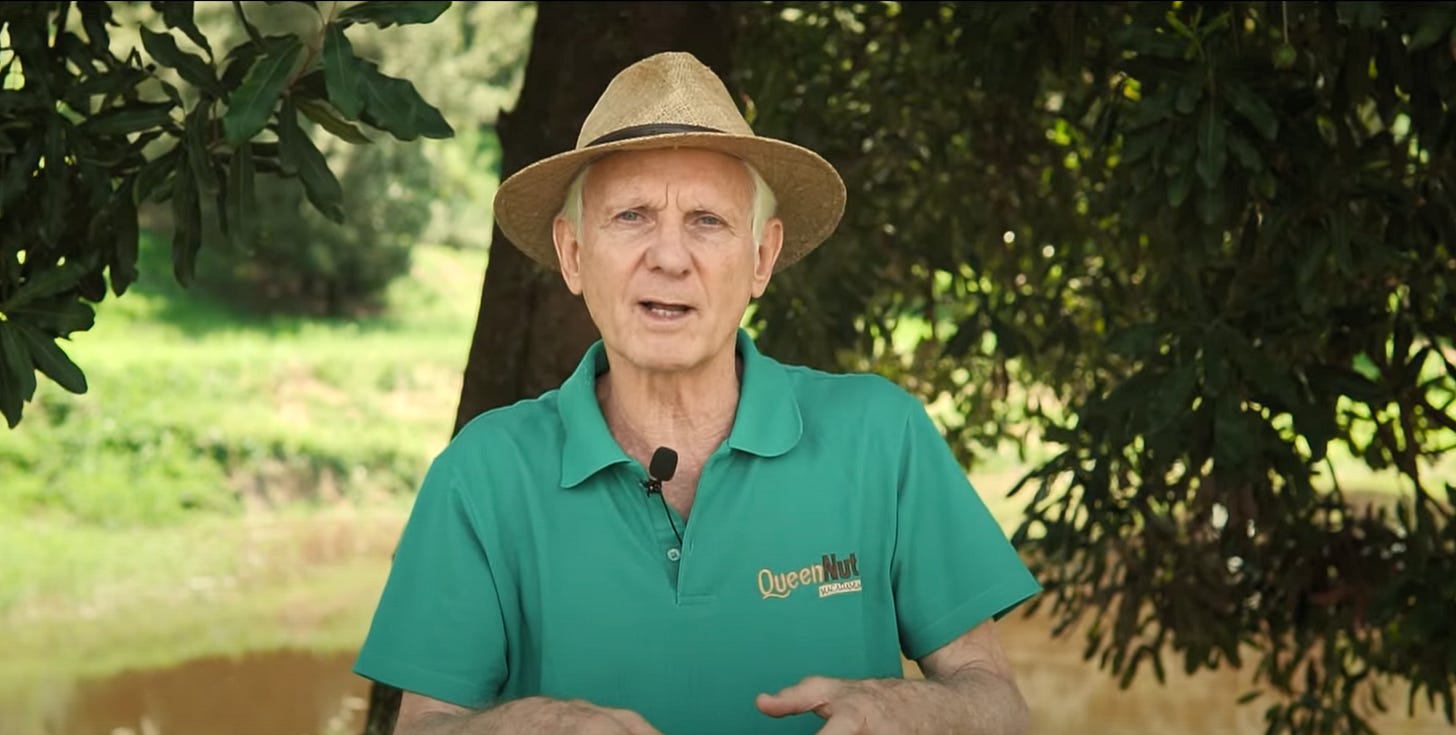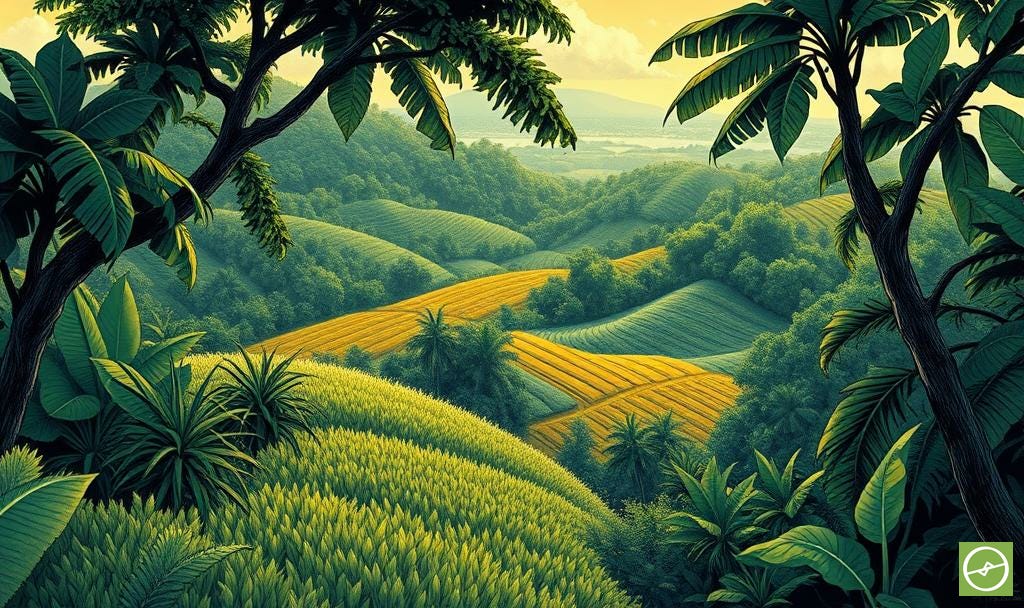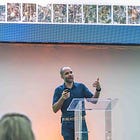The Macadamia Capital Pioneering Brazil's AgTech Frontier: Dois Córregos
From a diversification gamble in the 80's, Dois Córregos has evolved into Brazil’s macadamia powerhouse. But beneath the polished kernels and festival stalls lies a deeper story... one of reinvention.
A Seed Planted with Purpose
The journey began in 1988 when José Eduardo Camargo visited Hawaii and noticed a boom in macadamia orchards replacing sugarcane.
Inspired, José returned home to Brazil and convinced his father to let him plant trees on less-productive land.
“You can plant macadamia – just don’t take out any of my sugarcane,” was his father's only condition.
With no local reference points, they created an association, and imported technical knowledge, ie form of Professor Philip J. Ito. Eventually a nursery was also established, that supplied over 70% of the macadamia trees now planted in Brazil.
Professor Ito was a prominent horticulturist at the University of Hawaii's ‘College of Tropical Agriculture and Human Resources’. Co-authoring several publications on macadamia cultivation, including: "Macadamia Nut Cultivars Recommended for Hawaii" alongside Richard A. Hamilton.
Building an Industry from Scratch
At the time, macadamia processing infrastructure in Brazil was virtually non-existent. Machines were imported or adapted, and quality standards had to be established from the ground up.
“We developed everything. We went from how to crack a single nut, to developing all the machines you need, and a drying system.”
What followed was a 30-year investment in localised agri-processing know-how:
Post-harvest drying systems
Specialised nutcrackers
Defect detection protocols
Packaging lines for export
“We didn’t wait for research – we became the research.”
Today, Dois Córregos processes nearly half of Brazil’s exported macadamia crop.

Technologies Driving Brazil’s Macadamia Industry
Several standout technologies underpin this success story:
AI-Powered X-ray Sorting
These machines detect kernel defects internally, before cracking. This reduces fungal contamination risks and improves food safety.Optical Graders
Systems that grade for size, colour, and external defects using programmable logic and vision systems.Customised Nutcrackers
Designed for maximum kernel yield – preserving value at the most profitable end of the market (whole kernels).Controlled Drying Systems
Precision moisture reduction improves kernel shelf life and consistency across batches.Biological Pest Control
Documenting and monitoring of optimal predator-prey balance, supported by research with Embrapa and IAC.Carbon Farming through Cover Cropping
Integration of legumes and grasses to build soil biomass, suppress weeds, and regenerate fertility.BRC Global Certification Protocols
International food safety and traceability compliance, opening doors to large buyers like Unilever, Blue Diamond, and Kopenhagen.
A Regenerative and Scientific Approach
The farm's philosophy combines agronomic precision with ecological sensitivity. Regenerative practices – including reduced tillage, microbial diversity enhancement, and green manures – build long-term soil resilience.
In parallel, Embrapa collaborations have allowed for in-depth research into entomology and plant pathology, helping growers identify pests and diseases and manage them with minimal chemical inputs.
“The more life in the soil – from fungi to earthworms – the stronger the orchard.”
A Local Festival with Global Significance
Each year, the town of Dois Córregos hosts the Macadamia Festival, now attracting over 45,000 people. With more than 50 dishes on display, it’s not just a culinary celebration – it’s a public expression of local agricultural pride.
Since its early years, the event has grown into a platform for food innovation, community fundraising, awareness, and market expansion.
The macadamia industry in Dois Córregos is deeply personal. The vision was never just to build a business, but to create a new agricultural identity. One that merges tradition, innovation, and ecological thinking. The festival is a celebration of this ethos.
“It’s not just a business – it’s a dream we’re building, every harvest.”
AgTech Take-Aways
This isn’t just a story of one nut. It’s a roadmap for any region or grower wanting to invest in vertical integration, quality-first thinking, and adaptable technology.
Start with marginal land if you have to, but stick to known favourable growing conditions. Scale through continual agronomic learning. Especially true for areas without a track record.
Invest in tech that suits local production constraints. This may need to be specifically developed for your unique situation. But research for existing solutions you can use to accelerate development.
Embrace biological management, not only chemical use. Work with nature best you can for longterm results and sustainable practices.
Anchor growth in research and certification. Invest in building a pool of expertise, knowledge, and support. Look to the examples in Brazilian, South Africa, and Australian growing regions who are doing this well.
Remember strategic partnerships, both technical and commercial.
Tell your story – locally and globally - create awareness and drive demand.

Key Macadamia Producing Regions of Brazil
While São Paulo remains the core of Brazil’s macadamia industry - especially around Dois Córregos - other states like Minas Gerais, Espírito Santo, and Bahia are seeing steady growth as producers diversify from traditional crops.
Southern states like Paraná and Santa Catarina are testing cultivar adaptation in cooler climates, while Goiás and Mato Grosso do Sul are exploring macadamia in mixed-crop systems.
São Paulo (Interior): Centred around Dois Córregos, this is Brazil’s main production and export hub, with developed nurseries and processing infrastructure.
Minas Gerais: Particularly in the south and Zona da Mata, producers are diversifying from coffee and citrus into macadamia.
Espírito Santo: Some farms are incorporating macadamia into agroforestry systems alongside coffee, taking advantage of favourable microclimates.
Bahia: In southern Bahia, macadamia is grown in mixed systems, often with cacao, as part of sustainable agriculture initiatives.
Paraná & Santa Catarina: These cooler southern states have emerging plantings, with climate adaptation still under trial.
Goiás & Mato Grosso do Sul: Early-stage plantings exist in diversified farms, often linked to citrus and grain operations.
Further reading:
QueenNut Macadamia (Brazil) - History
Video: DOIS CÓRREGOS BERÇO DA MACADAMIA





![Recommended [AgTech] Books: An Updated Reading List](https://substackcdn.com/image/fetch/$s_!zFvm!,w_140,h_140,c_fill,f_auto,q_auto:good,fl_progressive:steep,g_auto/https%3A%2F%2Fsubstack-post-media.s3.amazonaws.com%2Fpublic%2Fimages%2F361c87a6-2a4a-4704-83d1-38900908b065_4000x2666.png)